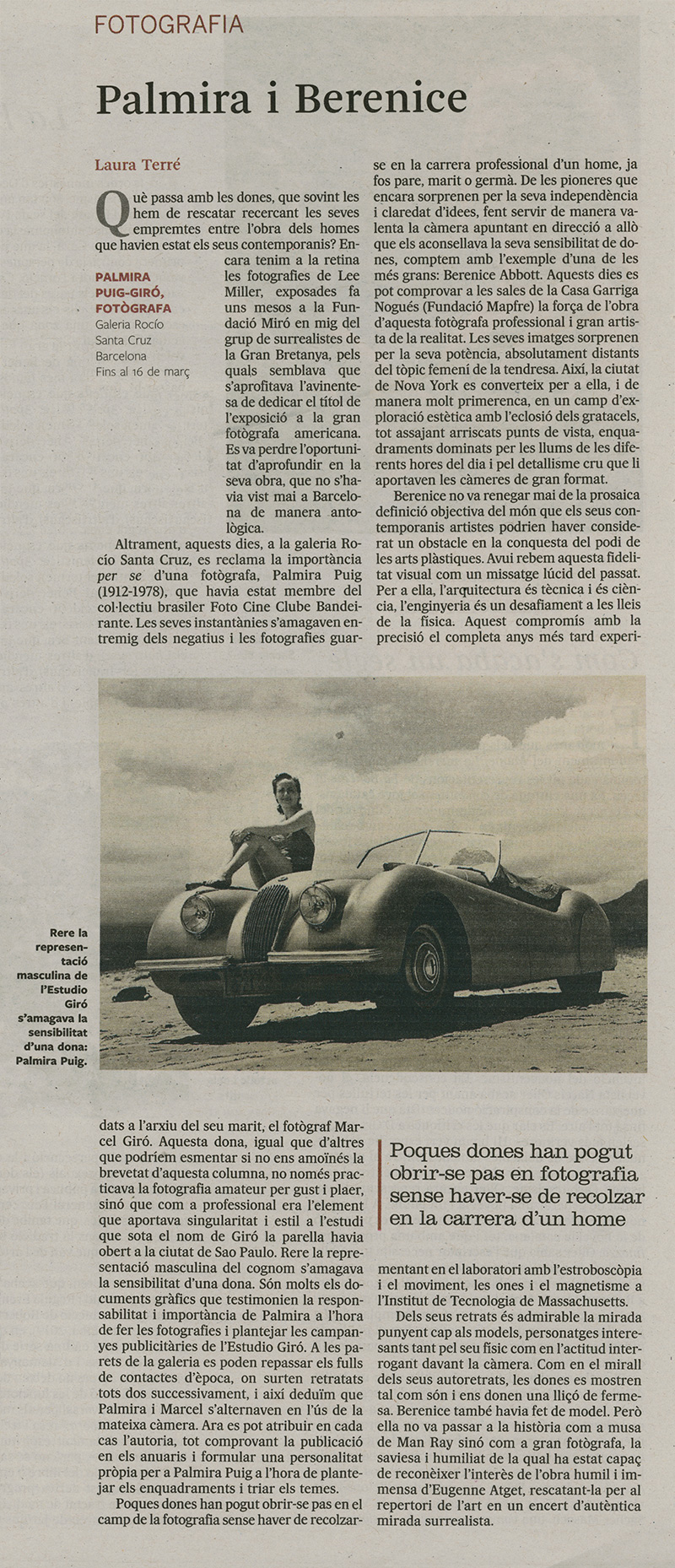Marcel Giró

Media
Palmira i Berenice
El País. Quadern. 7.3.2019
Laura Terré
Laura Terré
What happens with women, that we often have to rescue looking after their footprints among the work of men who had been their contemporaries? We still have to the retina the photographs of Lee Miller, exhibited a few months ago at the Miró Foundation in the midst of the group of surrealists from Great Britain, for which it seemed that he took advantage of the opportunity to dedicate the title of the exhibition to the great photographer American He missed the opportunity to deepen his work, which had never seen Barcelona in an anthological way.
Otherwise, these days, the gallery Rocío Santa Cruz, claims the importance per se of a photographer, Palmira Puig (1912-1978), who had been a member of the Brazilian collective Foto Cine Clube Bandeirante. Her snapshots were hidden in between the negatives and the photographs kept in the file of her husband, photographer Marcel Giró. This woman, as well as others we could mention if we did not lose sleep the brevity of this column, not only practiced amateur photography for pleasure and pleasure, but as a professional was the element that brought uniqueness and style to the study under the name of Giró the couple had opened in the city of Sao Paulo. Behind the male representation of the surname hid the sensitivity of a woman. There are many graphic documents that testify the responsibility and importance of Palmira when it comes to taking photographs and posing the advertising campaigns of the Estudio Giró. To the walls of the gallery you can review the contact sheets of the period, where they are portrayed both successively, and so we deduce that Palmira and Marcel alternated in the use of the same camera. Now authorship can be attributed in each case, checking the publication in the yearbooks and formulating a personal identity for Palmira Puig at the time of proposing the frames and choosing the themes.
Few women have been able to open up in the field of photography without having to rely on the career of a man, whether father, husband or brother. Of the pioneers who still surprise for their independence and clarity of ideas, bravely using the camera pointing in the direction of what advised their sensitivity to women, we have the example of one of the largest: Berenice Abbott. These days you can see in the rooms of the Casa Garriga Nogués (Mapfre Foundation) the strength of the work of this professional photographer and great artist of reality. His images surprise by their power, absolutely distant from the feminine topic of tenderness. Thus, the city of New York becomes for her, and very early, in a field of aesthetic exploration with the emergence of skyscrapers, rehearsing risky points of view, framings dominated by the lights of different times of day and by the raw detail provided by large-format cameras.
Berenice never denied the prosaic objective definition of the world that his contemporary artists could have considered an obstacle in the conquest of the podium of the plastic arts. Today we receive this visual fidelity as a lucid message from the past. For her, architecture is technical and science is, engineering is a challenge to the laws of physics. This commitment to accuracy is completed years later by experimenting in the laboratory with stroboscopy and movement, waves and magnetism at the Massachusetts Institute of Technology.
Of his portraits, the penetrating look towards the models is admirable, interesting characters both for his physique and for the attitude questioning before the camera. How in the mirror of their self-portraits, women show themselves as they are and give us a lesson in firmness. Berenice had also been a model. But she did not go down in history as Man Ray's muse but as a great photographer, the wisdom and humiliation of which she has been able to recognize the interest of the humble and immense work of Eugenne Atget, rescuing her for the repertoire of art in a right way of authentic surreal look.

